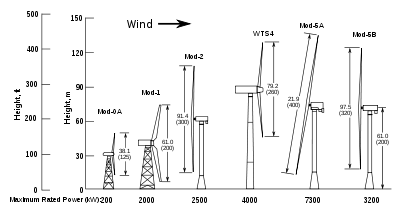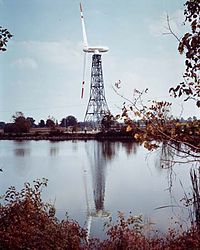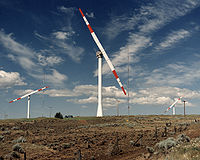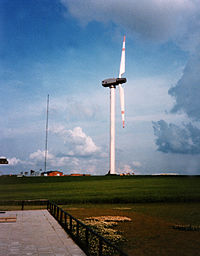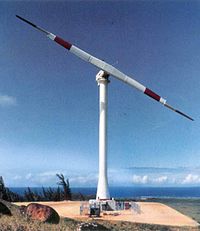- NASA wind turbines
-
Starting in 1975, NASA developed technologies and was the technical manager for the United States Department of Energy and the United States Department of Interior on a program to develop utility-scale wind turbines for the production of electric power, in response to the increase in oil prices.[1] A number of the world's largest wind turbines were developed and tested under this pioneering program. The development of the commercial industry however was delayed by a significant decrease in competing energy prices during the 1980's.
Contents
Program origin
In 1974, partially in response to the increase in oil price after the 1973 oil crisis, the Energy Research and Development Administration ERDA, later part of United States Department of Energy, appointed a department under the direction of Louis Divone to fund research into utility-scale wind turbines. NASA, through its Lewis Research Center in Sandusky Ohio (now the Glenn Research Center) was assigned the task of coordination of development by large contractors such as General Electric, Westinghouse, United Technologies and Boeing.
In 1975 NASA designed and built it first prototype wind turbine, the 100 kW Mod-0 in Sandusky Ohio under funding from the NSF and ERDA. The Mod-0 was modeled after the light weight two-bladed research turbine by Austrian Ulrich Hütter.[2] The two-bladed wind turbine with flexible or teetered rotor hubs characterized the NASA-led program. NASA and its contractors found that two blades can produce essentially equivalent energy as three blades but at a savings of the cost and weight of a blade. Also the rotational speed is increased for two-blade rotors reducing damaging stress and the gear ratio in the gearbox. Finally, the flexibility in the rotor minimizes the transfer of damaging bending loads into the drive train evidenced by the fact that none of the NASA wind turbines experienced gearbox failures that are often a problem for rigid rotor systems in use today.
The NASA program hosted technical conferences, inviting international partners. NASA even helped refurbish and operate the Danish three-bladed wind turbine at Gedser between 1977 and 1979, so that its operation and characteristics could be studied as a model for larger units. This 1957 unit designed by Johannes Juul (1887-1969) generated 200 kW for 11 years, and used a three-bladed upwind rotor with a lattice tower and blades supported partly by internal guy wires. The effort produce research data on its aerodynamic, electrical, and mechanical characteristics. An important result of this effort was the development of an engineering design model used by the industry for passive power control.[3]
As has been shown over time and by the market today that there are economies of scale achieved in larger units. NASA research and prototypes demonstrated that there were considerable scaling challenges in structural strength, fatigue, speed control, and aerodynamics. In the 1980's most wind turbines were relatively small units of only a few to 25 kW rating. Studies carried out by NASA's contractors suggested that much larger units would be required, on the order of 1 MW or more, for economic production of electricity by utilities.[4] Although the largest-diameter sets of propeller blades then in use were for helicopters, which spanned only 46 feet, it was projected that large blade sets, covering 200 to 300 feet in diameter, would be feasible to build and produce the lowest cost of energy.[4][5]
NASA/DOE/DOI Wind Turbines Model Rating kW Swept diameter, m Description Prime contractor Years in service Remarks MOD 0 100 38 Two blades, downwind and upwind NASA design with Lockheed blades 1975-1982 Prototype only at Sandusky MOD 0A 200 38 Two blades, downwind Westinghouse 1977-1984 Four units installed for field trials MOD 1 2000 61 Two blades, downwind General Electric 1979-1981 One installed at Howard's Knob. World's second multi-megawatt turbine. MOD 2 2500 91 Two blades, upwind Boeing 1982-1988 Three installed near Goodnoe Hills as a wind farm. Fourth and fifth units sold to utilities, Pacific Gas and Electric demolished in 1988 WTS 4 4000 79.2 Two blades, downwind United Technologies 1982-1994 One turbine installed at Medicine Bow, Wyoming and another smaller 3MW WTS 3 version in Sweden MOD 5A 7300 121.5 Two blades, upwind General Electric Never built MOD 5B 3200 97.5 Two blades, upwind Boeing 1987-1996 One installed at Oahu, Hawaii MOD-0 and MOD-0A
The first design developed was called MOD-0. This had a 38 metre diameter downwind two-bladed rotor, coupled to a synchronous generator, with a power rating of 100 kW at 8 m/s wind speed. A speed increaser stepped up the 40 r/min of the turbine to drive an 1800 r/min generator, with the power output of the machine regulated by pitching the rotor blades. MOD-0 was built near the Lewis Research Center in Sandusky, Ohio and became operational in September 1975. It served as a test bed for development of many concepts for use in larger units. The initial MOD-0 blades were made by Lockheed, out of aluminum. Structural problems surfaced almost immediately at the root end of the blades. Several significant changes and efforts were performed to address this. An investigation revealed that unexpectedly high cyclic loads were the result of a significant blockage of the wind by the complex truss tower structure. This caused the aerodynamic loads on the downwind rotor rapidly change. To correct this blockage, the access stairs were removed from the center of the tower.[6] A major blade material program was started that assessed fiberglass composite, steel, wood and even concrete. NASA approached the Gougeon Brothers, Inc. of Michigan to apply their boat material technology to wind turbines. The resulting wood and composite blades replaced the aluminum blades on th Mod-0 (and later Mod-0A), eliminating the blade root structural problems. Gougeon Brothers successfully commercialized their products into the wind turbine industry with sales around the world.
Many experiments were done with MOD-0 including brief operation in an upwind (rotor blades upwind of the tower) and a trial of a single blade for the turbine rotor. It tested the first variable speed generators as well prior to their use in the 3.2MW Mod-5B and later throughout the industry. The Mod-0 was also used to test the first steel shell towers, now the dominant tower design, the challenge being to take weight and cost out of the tower while safely passing through a resonance of the soft structure during startup.
Operating experience with the prototype MOD-0 provided the basis for construction of several demonstration units designated the MOD-0A. These were similar to the prototype with the same rotor size, but rated at 200 kW at slightly higher wind speed. Westinghouse was appointed as prime contractor responsible for the overall construction. Units were installed at Clayton New Mexico in 1977, Culebra, Puerto Rico in 1978, Block Island, Rhode Island in 1979 and the fourth at Kahaku Point Hawaii in 1980.
MOD-1
NASA contracted with General Electric in 1978 to scale up from the MOD-0A with a 10-fold increase in power. The Mod-1 was the world's second multi-megawatt wind turbine to be connected to a grid and also General Electrics first wind turbine. With a hub height of 46 meters above the ground, a larger rotor and a rating at a higher wind speed, it had a capacity of 2000 kW. The weight of the design prevented it from becoming a competitive commercial product, but a prototype was installed and run at Howard's Knob near Boone, North Carolina. The quick design cycle to multi-megawatt size based on the first generation Mod-0 caused technical and operational challenges. Low-frequency noise from the heavy truss tower blocking the wind to the downwind rotor caused problems to residences located close by. With additional pressure of a reduction in federal program funding, the turbine was dismantled in 1983.
MOD-2
In 1977 Boeing won the NASA and US-DOE contract for the design, fabrication, construction, installation and testing of several 2.5-megawatt wind turbine models in the United States. The first four MOD-2 models went into operation during the early 1980s. The dedication ceremony for the first three turbines was held on April 17, 1980, at Goodnoe Hills, Washington. On September 2, 1982, a fourth began operating at Medicine Bow, Wyoming.[7]
The Bonneville Power Administration bought the generated electricity of the Goodnoe Hills turbines and integrated it into the regional power grid. During the periods of May 1981, the three turbines at the Goodnoe Hills site formed the first wind farm in the world.[7] The Goodnoe Hills site was primarily a research project for Boeing, Bonneville Power Administration, NASA and the Battelle Memorial Institute. The Solar Energy Research Institute also evaluated the suitability of megawatt-class wind turbines as a source of electricity. During 1986, the MOD-2 wind turbines of Goodnoe Hills were dismantled. In 1985, the last full year of operation, the combined electrical output of the three turbines was 8,251 megawatt-hours. The Medicine Bow MOD-2 wind turbine was sold for scrap in 1987.[7]
In 2008, the Goodnoe Hills Wind Farm opened on the same site with 47 REpower 2.0 MW wind turbines for a combined nameplate capacity of 94 MW. enXco/Power Holdings owns the wind farm, with PacifiCorp as the power purchaser.[8]
WTS-4
The WTS-4 (4 megawatt) wind turbine in Wyoming was designed by United Technologies (Hamilton Standard Division), under the technical management of NASA and with funding from the United States Department of Interior. The WTS-4 was placed into operation in Medicine Bow, Wyoming in 1982. It featured a “soft” steel tube tower, fiberglass blades, torsional springs and dashpots in the drivetrain, and a flexible teetered hub. To this day, the WTS-4 is the most powerful wind turbine to have operated in the US and it held the world record for power output for over 20 years. A second commercial prototype with a smaller generator (3 megawatts) designated the WTS-3 was constructed and operated in Sweden.
MOD-5B
The MOD-5B wind turbine, built in 1987, was the largest operating wind turbine in the world in the 1990's. The contract to build the Mod-5B was awarded to Boeing in 1980 and it was installed on Oahu in 1987.[9] With a rated capacity of 3.2 megawatts, it weighed 426,000 kg (940,000 lb) and had a 100 m (330 ft) diameter two-blade rotor on a 60 m (200 ft) steel tower.[7] Early operation of the Mod-5B demonstrated a good availability of 95 percent for the new first-unit wind turbine. Early in 1988, operation of the turbine was transferred to Hawaiian Electric Industries, then to the Makani Uwila Power Corporations (MUPC), and kept in service intermittently until late in 1996. Because of financial difficulties, the wind turbine was shut down, along with the rest of MUPC, and passed to the property owner, Campbell Estates.[7] Campbell Estates decided to disassemble the unit and sell it for scrap.[10] The DOE salvaged the drive train gearbox and generator in July 1998.[7]
Program Legacy
None of the NASA prototypes became commonly produced as commercial generators because the purpose of the program was to develop the technology and support the emerging industry. Many of the technologies such as doubly fed variable speed generators, light weight tubular towers, and the engineering design tools used in the wind industry today were developed and pioneered by the NASA program[11]. Total cost of the program between 1974 and 1992 was $330 million. For reference, the global wind market had reached $47 billion annually by 2008[12]. General Electric, Boeing Engineering and Construction, Westinghouse and United Technologies were the commercial partners on the program, some of whom are involved in the wind industry today. Although it has widely been stated that no commercial designs were produced[4], NASA's industry partners did indeed produce commercial turbines during this program such as the Boeing Mod-2 (described earlier) and Westinghouse 600 kW turbines at Kahuku wind farm in Hawaii[13]. When oil prices declined by a factor of three from 1980 through the early 1990's during what came to be known as the "1980s oil glut", many turbine manufacturers, both large and small, left the business. The commercial sales of the NASA/Boeing Mod-5B, for example, came to an end in 1987 when Boeing Engineering and Construction announced they were "planning to leave the market because low oil prices are keeping windmills for electricity generation uneconomical."[14]
See also
- History of wind power
- List of power stations in Washington
- Wind power in Washington
- Smith-Putnam wind turbine
References
- ^ Peter Asmus, Reaping the wind: how mechanical wizards, visionaries, and profiteers helped shape our energy future Island Press, 2001 ISBN 1559637072 pages 54-56
- ^ http://www.eoearth.org/article/H%C3%BCtter,_Ulrich Ulrich Hütter 2008
- ^ http://ntrs.nasa.gov/archive/nasa/casi.ntrs.nasa.gov/19820025954_1982025954.pdf , Viterna and Janetzke, Theoretical and Experimental power From Large Horizontal-Axis Wind Turbines, NASA TM-82944, 1982
- ^ a b c Paul Gipe, Wind Energy Comes of Age, John Wiley and Sons, 1995, ISBN 047110924X, pp.103-106
- ^ http://www.windsofchange.dk/WOC-usastat.php Stories of a dawning wind power industry, retrieved 2011 01 03
- ^ http://eece.ksu.edu/~gjohnson/Windbook.pdf Gary L. Johnson, Wind Energy Systems (electronic edition),2006, page 1-8
- ^ a b c d e f "MOD-2/MOD-5B Wind Turbines". Boeing. http://www.boeing.com/history/boeing/windturbine.html. Retrieved 2009-06-30.
- ^ "U.S. Wind Energy Projects - Washington". American Wind Energy Association. 2009-12-31. http://www.awea.org/projects/Projects.aspx?s=Washington. Retrieved 2010-03-14.[dead link]
- ^ "The evolution of the Mod-2 and Mod-5B Wind Turbine Systems". Intersociety Energy Conversion Engineering Conference. 1985. http://adsabs.harvard.edu/abs/1985iece....3S...3B. Retrieved 2009-06-30. "The Mod-5B, awarded to Boeing in 1983, is to be installed on the island of Oahu in 1986. The 3.2 mw Mod-5B design has benefitted from the Mod-2 operational and test experience. In addition, major performance improvements have been incorporated in the design. The Mod-5B is designed to produce 43 percent more energy than the Mod-2 as originally delivered."
- ^ Easterbrook, Gregg (June 28, 2009). "The Dirty War Against Clean Coal". New York Times. http://www.nytimes.com/2009/06/29/opinion/29easterbrook.html?em. Retrieved 2009-06-30. "The Energy Department has also financed such overpriced, unrealistic projects as the MOD-5B, a wind turbine that weighed 470 tons and stood 20 stories tall: it looked like a gigantic propeller intended to push the earth to a new star system. It ended up being sold for scrap."
- ^ David Spera, Editor, Wind Turbine Technology ASME Press, 2009 ISBN 978-0-7918-0260-1
- ^ http://www.google.com/hostednews/afp/article/ALeqM5gko0QmIaJ8jg0oNeiaU3ql5VRwPw, Wind energy gathers steam, US biggest market: survey (AFP),2009
- ^ http://hawaii.gov/dbedt/ert/wwg/history.html, History of Wind Energy Projects in Hawaii, State of Hawaii, 2002
- ^ http://www.seattlepi.com/archives/1987/8701230009.asp Hawaiians get Boeing's Last Wind Machine Makani Ho'Olapa will Bring Power to 1,140 Residences 1987
Further reading
- M. B. Douthwaite Enabling innovation: a practical guide to understanding and fostering technological changeZed Books, 2002 ISBN 1856499723, pp.96-101
Categories:- NASA technology spinoffs
- Wind turbines
Wikimedia Foundation. 2010.

